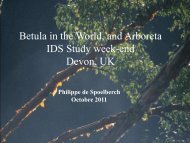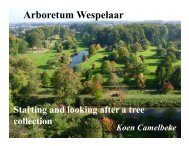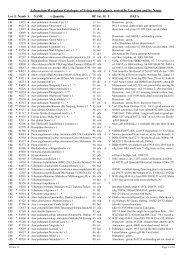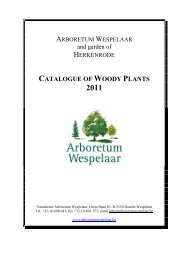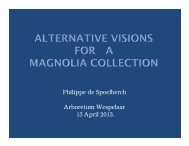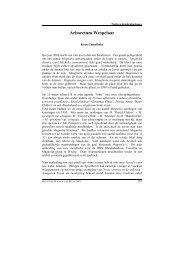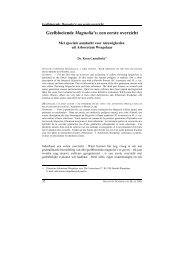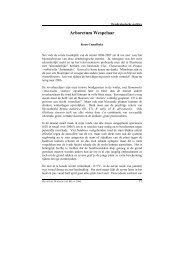Oleaceae – The olive family
Systematics of Fraxinus - Arboretum Wespelaar
Systematics of Fraxinus - Arboretum Wespelaar
You also want an ePaper? Increase the reach of your titles
YUMPU automatically turns print PDFs into web optimized ePapers that Google loves.
<strong>Oleaceae</strong> <strong>–</strong> <strong>The</strong> <strong>olive</strong> <strong>family</strong> <br />
• Basal posi3on in the Lamiales <br />
• 24 extant genera with about 600 <br />
species <br />
• Mainly trees and shrubs, occurring <br />
on all con3nents, from temperate <br />
to tropical areas <br />
• Some well-‐known insect-‐pollinated <br />
genera: Jasminum, Forsythia, <br />
Syringa, Ligustrum <br />
• 6 genera with wind-‐pollinated <br />
species: Fraxinus, Olea, Nestegis, <br />
Phillyrea, Fores9era and <br />
Priogymnanthus
Insect-polliated<br />
<br />
genera of <br />
<strong>Oleaceae</strong> <br />
Jasminum ni9dum <br />
Ligustrum vulgare <br />
Forsythia x intermedia <br />
Chionanthus virginicus <br />
Syringa re9culata
Wind-‐pollinated <br />
genera of <br />
<strong>Oleaceae</strong> <br />
Phillyrea la9folia <br />
Fores9era pubescence <br />
Nestegis sandwicensis <br />
Olea europaea <br />
Fraxinus excelsior
Overview of Fraxinus <br />
• First described by Linnaeus in 1753 <br />
• Fraxinus derived from ”phraxo” = fenced <br />
or ”phraxis” = split <br />
• Almost 800 taxa described but… <br />
• I accept 49 species <br />
• Distributed in the northern hemisphere <br />
• Mostly trees, a few shrubs in dry areas <br />
• Pinnately compound leaves and samaras <br />
• Both wind-‐ and insect-‐pollinated species <br />
• Remarkable diversity of breeding systems <br />
(hermaphrodites, androdioecy, andromonoecy, <br />
polygamy, dioecy) <br />
• Commercially important, e.g. F. americana <br />
• Many ornamental species, e.g. F. ornus
Old and new classifica3ons of Fraxinus <br />
Lingelsheim (1920) <br />
Sec3on Ornus <br />
subsec3on Euornus (20) <br />
subsec3on Ornaster (5) <br />
Sec3on Fraxinaster <br />
subsec3on Dipetalae (1) <br />
subsec3on Pauciflorae (5) <br />
subsec3on Sciadanthus (1) <br />
subsec3on Melioides (16) <br />
subsec3on Bumeliodes (15) <br />
Wallander (2008), updated 2012 <br />
Sec3on Dipetalae (3) <br />
Sec3on Ornus (15-‐>16) <br />
Sec3on Fraxinus (5) <br />
Sec3on Pauciflorae (5) <br />
Sec3on Sciadanthus (2) <br />
Sec3on Melioides (10-‐>15) <br />
incertae sedis (3) <br />
63 species 43-‐>49 species
Sec3onal classifica3on of Fraxinus <br />
Fraxinus <br />
(5 species) <br />
F. angus9folia <br />
F. excelsior <br />
F. mandshurica <br />
F. nigra <br />
F. platypoda <br />
Sciadanthus <br />
(2 species) <br />
F. hubeiensis <br />
F. xanthoxyloides <br />
Pauciflorae <br />
(5 Mesoamerican species) <br />
F. dubia <br />
F. gooddingii <br />
F. greggii <br />
F. purpusii <br />
F. rufescens <br />
Ornus <br />
(16 Eurasian species) <br />
F. aper9squamifera <br />
F. baroniana <br />
F. bungeana <br />
F. chinensis <br />
F. floribunda <br />
F. griffithii <br />
F. hopeiensis <br />
F. lanuginosa <br />
F. longicuspis <br />
F. malacophylla <br />
F. micrantha <br />
F. ornus <br />
F. paxiana <br />
F. raibocarpa <br />
F. sieboldiana <br />
F. trifoliolata <br />
Dipetalae <br />
(3 American species) <br />
F. anomala <br />
F. dipetala <br />
F. quadrangulata <br />
Melioides <br />
(15 American species) <br />
F. albicans <br />
F. americana <br />
F. berlandieriana <br />
F. biltmoreana <br />
F. caroliniana <br />
F. coriacea <br />
F. cubensis <br />
F. la9folia <br />
F. papillosa <br />
F. pauciflora <br />
F. pennsylvanica <br />
F. profunda <br />
F. smallii <br />
F. uhdei <br />
F. velu9na <br />
Incertae <br />
sedis <br />
(3 species) <br />
F. cuspidata <br />
F. chiisanensis <br />
F. spaethiana
Sec3on Fraxinus <br />
• 2 European, 2 Asian and 1 American species <br />
• Large deciduous, wind-‐pollinated trees <br />
• Apetalous flowers with no calyx (American F. <br />
nigra with deciduous calyx) <br />
• Lateral infloresences, terminal leaf shoots <br />
• Dioecious, andromonoecious or polygamous <br />
F. platypoda <br />
F. excelsior <br />
F. mandshurica <br />
F. nigra <strong>–</strong> Black ash <br />
F. angus9folia
Fraxinus excelsior -‐ <br />
European or Common ash <br />
• Distributed in northern and central Europe <br />
• Large deciduous tree, up to 35 m <br />
• Polygamous but func3onally dioecious
Fraxinus angus9folia -‐ Narrow-‐leafed ash <br />
• ssp. angus9folia in SW Europe and NW Africa <br />
• ssp. oxycarpa in SE & C Europe (Caucasian ash), <br />
syn. F. pallisiae <br />
• ssp. syriaca from Turkey to Central Asia (Syrian <br />
ash), syn. F. potamophila, F. sogdiana <br />
• Large deciduous trees (up to 30 m) <br />
• Andromonoecious <br />
• Racemes (F. excelsior panicles)
F. mandshurica <strong>–</strong> Manchurian ash <br />
• Distributed in eastern Asia (China, <br />
E Russia, Korea) <br />
• Large, deciduous, dioecious tree <br />
• Important 3mber tree <br />
• Dioecious, with anther rudiments <br />
in female flowers
Sec3on Sciadanthus <br />
• 2 species <br />
<strong>–</strong> F. xanthoxyloides <strong>–</strong> Afghan or <br />
Algerian ash <strong>–</strong> a small tree or <br />
shrub in N Africa and the <br />
Himalayas <br />
<strong>–</strong> F. hubeiensis, medium-‐sized tree <br />
in China <br />
• Small compound leaves with <br />
winged leaf-‐rachis <br />
• Many-‐flowered inflorescences <br />
• Polygamous, wind-‐pollinated <br />
flowers <br />
• Calyx but no petals (male <br />
flowers of F. xanthoxyloides <br />
have no calyx) <br />
• Large clustered samaras <br />
F. hubeiensis <br />
F. xanthoxyloides <br />
F. xanthoxyloides
Sec3on Pauciflorae <br />
• 5 species in arid regions of <br />
south-‐western USA, Mexico <br />
and Guatemala <br />
• Small trees or shrubs with <br />
small coriaceous leaves <br />
• Small compound leaves with <br />
winged leaf-‐rachis <br />
• Few-‐flowered inflorescences <br />
• Apetalous, wind-‐pollinated <br />
flowers, with calyx <br />
• Small samaras <br />
F. dubia <br />
F. gooddingii <br />
F. greggii <br />
F. purpusii <br />
F. rufescens <br />
F. greggii <strong>–</strong> Ligleleaf ash
F. gooddingii <br />
Arizona and Sonora <br />
F. greggii <br />
Texas and NE <br />
& C Mexico <br />
F. rufescens <br />
C Mexico
F. purpusii <br />
NE & C Mexico, Guatemala <br />
F. dubia <br />
E Mexico, Guatemala
Sec3on Melioides <br />
• 15 American species <br />
• Large or small, deciduous, wind-pollinated<br />
trees <br />
• Apetalous, unisexual flowers with <br />
calyx <br />
• Dioecious (without rudimentary <br />
organs of the opposite sex) <br />
F. americana <br />
F. pennsylvanica
Western and south-‐<br />
western ashes <br />
• F. albicans <strong>–</strong> Texas ash <br />
• F. berlandieriana -‐ Mexican ash <br />
F. latifolia<br />
• F. coriacea <strong>–</strong> Leather-‐leaved ash <br />
• F. la9folia <strong>–</strong> Oregon ash <br />
• F. papillosa <strong>–</strong> Chihuahuan ash <br />
• F. velu9na <strong>–</strong> Velvet, Desert, Arizona ash <br />
• F. uhdei <strong>–</strong> Tropical or Shamel ash <br />
F. velutina
South-‐western ashes <br />
F. papillosa<br />
F. berlandieriana<br />
F. uhdei<br />
F. albicans
Eastern and south-‐eastern ashes <br />
• F. americana (2n) -‐ White ash <br />
• F. smallii (4n) <strong>–</strong> Small’s ash <br />
• F. biltmoreana (6n) <strong>–</strong> Biltmore ash <br />
• F. caroliniana <strong>–</strong> Water or Carolina ash <br />
• F. cubensis <strong>–</strong> Cuban water ash <br />
• F. pauciflora <strong>–</strong> Swamp ash <br />
• F. pennsylvanica <strong>–</strong> Green and Red ash <br />
• F. profunda (6n) <strong>–</strong> Pumpkin ash
Polyploid complex <br />
F. americana s.s (2n) F. smallii (4n) F. biltmoreana (6n)
Eastern ashes <br />
F. profunda<br />
F. caroliniana<br />
F. pennsylvanica F. pauciflora
Sec3on Dipetalae <br />
• 3 American species <br />
• F. anomala and F. dipetala, small <br />
trees in SW USA and Mexico <br />
• F. quadrangulata, large tree in C <br />
and E USA and Canada <br />
• Hermaphrodite flowers in lateral <br />
inflorescences <br />
• Quadrangular shoots <br />
Fraxinus dipetala <br />
Two-‐petal ash <br />
Fraxinus anomala <br />
Single-‐leaf ash <br />
F. quadrangulata -‐ Blue ash
Fraxinus anomala <br />
• Deserts of Utah, Arizona, Nevada, Colorado, New <br />
Mexico, California and Mexico <br />
• Small tree or shrub, 2-‐5 m, crown round-‐topped, <br />
with contorted branches <br />
• var. anomala unifoliate, var. lowellii trifoliate
Fraxinus dipetala <br />
• Dry areas of Utah, Arizona, Nevada, California <br />
• Small tree or shrub <br />
• Only ash with two petals, sweet fragrance <br />
• Trifoliate variety <br />
var . dipetala<br />
var. trifoliata
Sec3on Ornus <br />
• 16 Eurasian species <br />
• Terminal inflorescences and <br />
leaf shoots <br />
• Flowers with the leaves <br />
• Two morphological groups: <br />
<strong>–</strong> Insect pollinated, four showy <br />
white petals, scented, but no <br />
nectar, hermaphrodites or <br />
androdioecious <br />
<strong>–</strong> Wind-‐pollinated apetalous <br />
flowers, delayed leafing, <br />
androdioecious or dioecious <br />
(F. baroniana, F. chinensis, <br />
F. longicuspis, F micrantha)
Sec3on Ornus <br />
Central Asia<br />
F. raibocarpa (C Asia) <br />
F. floribunda (Afghanistan through Himalaya to SE Asia) <br />
Europe<br />
F. ornus (C and E <br />
Mediterranean) <br />
Himalaya<br />
F. micrantha <br />
F. paxiana (+ China)<br />
East Asia<br />
F. apertisquamifera (Japan)<br />
F. baroniana (China)<br />
F. bungeana (China)<br />
F. chinensis (China, Japan, Korea, SE Russia, Vietnam)<br />
F. griffithii (SE Asia)<br />
F. hopeiensis (China)<br />
F. lanuginosa (Japan)<br />
F. longicuspis (Japan)<br />
F. malacophylla (China, Thailand)<br />
F. sieboldiana (China, Japan, Korea)<br />
F. trifoliolata (China)
Fraxinus ornus -‐ Manna ash <br />
• Distributed in C & E Mediterranean <br />
• Small tree (up to 10 m) <br />
• Both wind-‐ and insect-‐pollinated flowers, <br />
fragrant <br />
• Androdioecious (separate male and <br />
hermaphrodite trees)
Fraxinus chinensis <strong>–</strong> Chinese ash <br />
• Deciduous tree, 3-‐20 m <br />
• Func3onally dioecious <br />
• ssp. chinensis distributed in China, <br />
Korea, Vietnam, Thailand <br />
• ssp. rhynchophylla distributed in <br />
China, Korea, Japan, SE Russia <br />
Fraxinus longicuspis <br />
Hermaphrodite <br />
Male
Other species of sec3on Ornus <br />
two pairs of<br />
inner bud scales<br />
Fraxinus griffithii <br />
one pair of inner<br />
bud scales<br />
Fraxinus sieboldiana <br />
Fraxinus lanuginosa
More species of sec3on Ornus <br />
F. paxiana<br />
F. bungeana<br />
<strong>The</strong> rare F. baroniana<br />
F. malacophylla<br />
F. floribunda
Incertae sedis <br />
• F. spaethiana (Japan) <br />
• F. chiisanensis (Korea) <br />
• F. cuspidata <strong>–</strong> Fragrant ash <br />
<strong>–</strong> a small tree in arid areas <br />
of SW USA and Mexico <br />
F. spaethiana <br />
F. cuspidata F. chiisanensis <br />
F. chiisanensis
Uncertain3es remaining <br />
• Posi3on of the three incertae sedis <br />
• F. platypoda = F. spaethiana? <br />
• F. pringlei? (Mexico) <br />
• Delimita3ons and synonyms in the Pauciflorae <br />
• Status of F. papillosa <br />
• F. angus9folia complex <br />
• F. chinensis complex
Thank you for your agen3on! <br />
Photos: Eva Wallander<br />
Photo credits also to:<br />
Consuelo Bonfil<br />
Wong-Ki Min<br />
Guy Nesom<br />
Philippe de Spoelberch<br />
Various internet sources (Wikipedia, CalPhotos, plant.ac.cn, asianflora.com)



